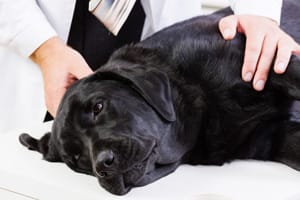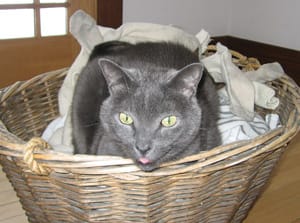5 Tips to Keeping Your Furry Friend Healthy and Well Fed
By Linley Dixon, PhD
 |
suggest there has been a spike in serious intestinal maladies in pets. Americans spend about $22 billion on pet food each year. Source: DollarPhotoClub.com |
Pet food quality varies significantly and all too often includes dangerous chemical additives. In many cases consumers get what they pay for, but price doesn’t always indicate high quality. The good news is that discriminating shoppers will soon have a new tool helping them to weed through product labels and separate the good from the bad.
The Cornucopia Institute has completed a thorough analysis of the pet food industry and will release a detailed report this winter.
Our study reveals that many complete diet products significantly sway from the natural, wild diets of cats and dogs in terms of protein, fat and carbohydrate percentages. The majority of both dog and cat food product formulations contain too many grains and starches, including corn, wheat, rice, oats, peas, and potatoes. In addition, many products contain questionable and/or unnecessary ingredients.
Meanwhile, among the most common causes of death for both cats and dogs are diseases affiliated with poor diet including obesity, cardiovascular disease, gastrointestinal diseases and cancer.
Cornucopia’s report examines specific ingredients to avoid and includes a web-based buyer’s guide that will help consumers find high quality and safe pet foods. In the meantime, the following tips will help you get started finding the best food for your cats and dogs.
1. Avoid carrageenan:
You may be unknowingly harming your pets by feeding them wet food, even from the most expensive “premium” brands—despite extra care taken to find formulations high in animal-based proteins, low in fat and carbohydrates, and even USDA certified organic. Our research found that greater than 70% of canned pet foods contain carrageenan, a non-nutritive food stabilizer extracted from red seaweed. Peer-reviewed and published research indicates that carrageenan is known to cause intestinal inflammation with the potential to lead to cancer, even in small doses.
Carrageenan is a non-nutritive thickener and emulsifier that can easily be replaced by safer alternatives in pet foods, including tomato paste, guar gum, potato starch, pea starch, tapioca, and garbanzo bean flour.
New independent research (published in 2014) at the Jesse Brown VA Medical Center in Chicago, using both human and mouse epithelial cells, further demonstrates the mechanism by which inflammatory responses occur after carrageenan exposure using doses less than the anticipated average daily intake (50 mg/30 g mouse vs. 250 mg/60 kg person). This research demonstrates for the first time that carrageenan-induced inflammation occurs in both humans and mice, indicating that it is likely to cause a similar reaction in all mammals, including cats and dogs.
Pets that eat primarily wet food with carrageenan will consume daily doses of carrageenan in amounts known to cause inflammation. In fact, inflammatory bowel disease (IBD) in cats is the most common cause of vomiting and diarrhea.
Unfortunately, policy changes are often years behind the latest scientific research due to corporate lobbying and industry-funded studies that conflict with independent research.
Some pet food brands are now advertising that they do not include carrageenan, such as Zignature dog food and Weruva cat food. Meanwhile, Hill’s Science Diet contains carrageenan, despite the label stating the brand is “veterinary recommended.”
2. Buy organic (but without carrageenan):
Many high-end “natural” pet foods contain carrageenan—and even Newman’s Own Organics wet cat food (which is not actually certified organic but, rather, “made with” organic ingredients) contains the ingredient. Organic foods should be a safe haven from chemical residues, antibiotics and questionable synthetic ingredients. Sadly, in this case, pet owners need to pay extra attention.
There are two USDA Organic wet dog food brands that do not contain carrageenan: Organix and Cocolicious. However, there are no certified organic cat food brands that do not use carrageenan in at least one of their flavors. It is important to read each product label; Organix cat food shredded chicken flavors, for example, contain carrageenan although the majority of the brand’s flavors do not.
3. Don’t fall for non-GMO claims (unless you see the USDA Organic label):
Some pet food brands, such as Wellness, advertise that they are “made with naturally GMO-free ingredients.” This is likely an intentionally misleading claim. Without the USDA Organic label, you can assume that the feed given to the livestock used to produce these pet food products is almost certainly GMO.
Wellness brand products do not display the USDA Organic seal. Over 90% of the soybean and corn currently produced in the U.S. is GMO. Though pet foods can test to be GMO-free, this does not mean that the meat animals were fed GMO-free feed throughout their life.
The USDA Food Safety Inspection Service has only recently approved a non-GMO label for meat only if that producer can prove all the animal feed required to feed the number of animals owned is GMO-free. This label is currently missing from all pet food brands, despite non-GMO claims. Thus, only the presence of the USDA Organic label reliably ensures that meat animals were fed non-GMO grain.
4. Avoid these ingredients, too:
Pet food manufacturers don’t advertise the fact that pet food is composed primarily from food industry waste. Animal fat and animal meat and bone meal (MBM) are common pet food ingredients that are products of rendering (boiling waste products to sterilize them). Animal fat and MBM often come from a mix of different animal species, including expired grocery store meat, animals that died on the farm, and restaurant scraps, including used grease from deep-fat fryers.
Animal fat and MBM are the ingredients in pet food most likely to correlate with the presence of sodium pentobarbital, the drug used by veterinarians and shelters for euthanasia. Needless to say, these are not ingredients you want your dog and cat to be eating.
Corn gluten meal should also be avoided. It is used primarily as a cheap substitute for meat since cats and dogs are carnivorous and should have diets primarily based on meat.
In addition, synthetic preservatives should be avoided, including BHA, BHT, and propyl gallate, since research has linked them to several health concerns, including cancer. Natural preservatives, such as ascorbic acid (vitamin C), tocopherols (vitamin E), and plant-based oils (such as rosemary oil), are better alternatives.
5. Home-cook your pet’s food:
One way to ensure a healthy diet for your companion animals is to cook for them yourself. Many chronic problems such as allergies, vomiting, diarrhea, and skin problems can be solved with homemade meals. Cornucopia’s report provides veterinarian-approved recipes and advice for cooking at home for both cats and dogs.
In conclusion, the pet food industry is no different than leading marketers of human food when it comes to cheap substitutes and false health claims. Take matters into your own hands by reading labels and choosing high quality ingredients. Cornucopia’s soon-to-be-released report can help you.

Moe, the longtime feline companion of Codirector Mark Kastel.
Sadly, just after Cornucopia completed its report on carrageenan in human food,
Moe died in 2013 of intestinal cancer likely linked to carrageenan in his diet.
Watch for the release of the Pet Food Guide this winter.
See Cornucopia’s report Carrageenan: The “Natural” Additive that’s Making Us Sick, the Carrageenan Shopping Guide, and a questionnaire on the effects of eliminating carrageenan from the diet. Also sign the petition telling the FDA to remove carrageenan from our food supply.

